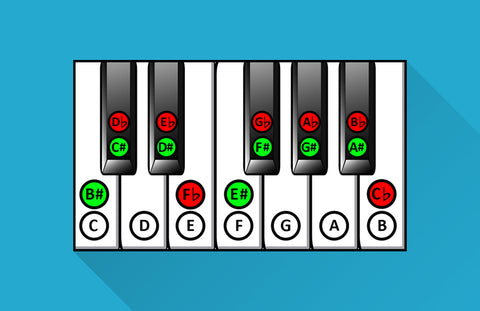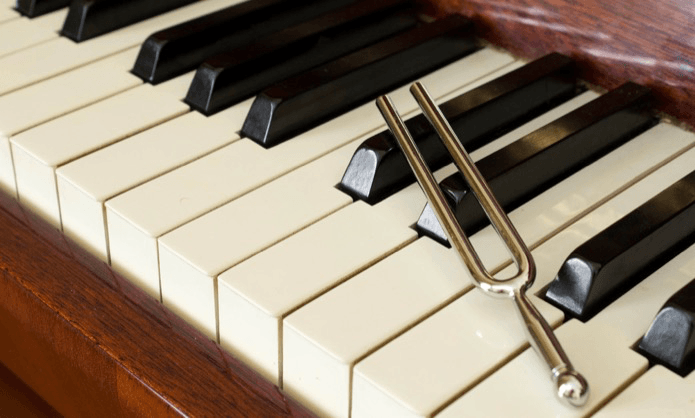Today, our guest Neil from sublimelody brings us visual and clear mathematical proof why every piano is out of tune.
First, let’s talk about perfect octave and perfect fifth.
What is a Perfect Octave 2:1?
In music, an octave or perfect octave is the interval between one musical pitch and another with half or double its frequency. (wikipedia.org Link: https://en.wikipedia.org/wiki/Octave)
The perfect octave spans twelve semitones, correlated with 12 keys (5 black and 7 white keys) of an octave on the piano keyboard:

2:1 is the just interval (Link: https://en.wikipedia.org/wiki/Just_intonation) of a perfect octave, which is the ratio between the frequency of the one musical pitch with its half frequency.
For example, the frequency of C4 is 261.63 Hz so C5 will be 523.25 Hz (2 x 261.63 = 523.25) (mtu.edu Link: https://pages.mtu.edu/~suits/notefreqs.html)
Now, let count the frequencies of C1 to C8 by octaves on the piano keyboard.
From the frequency of C1 is 32.70 Hz, we will have:
- C2 = 2.C1
- C3 = 2.C2 = 22.C1
- C4 = 2.C3 = 22.C2 = 23.C1
- C5 = 2.C4 = 22.C3 = 23.C2 = 24.C1
- C6 = 2.C5 = 22.C4 = 23.C3 = 24.C2 = 25.C1
- C7 = 2.C6 = 22.C5 = 23.C4 = 24.C3 = 25.C2 = 26.C1
- C8 = 2.C7 = 22.C6 = 23.C5 = 24.C4 = 25.C3 = 26.C2 = 27.C1

What is a Perfect Fifth 3:2?
In music theory, a perfect fifth is a musical interval corresponding to a pair of pitches with a frequency ratio of 3:2, or very nearly so.
The perfect fifth spans seven semitones, while the diminished fifth spans six and the augmented fifth spans eight semitones.
For example, the interval from C to G is a perfect fifth, as the note G lies seven semitones above C. (wikipedia.org Link: https://en.wikipedia.org/wiki/Perfect_fifth)
3:2 is the just interval of a perfect fifth.
For instance, the frequency of C4 is 261.63 Hz and G4 is 392.00 Hz. The ratio 392.00:261.63 equals to 3:2. (mtu.edu Link: https://pages.mtu.edu/~suits/notefreqs.html)
Let count the frequencies of C1 to C8 on the piano keyboard by perfect fifths.
- C1 to G1: G1 = (3/2).C1
- G1 to D2: D2 = (3/2).G1 = (3/2)2.C1
- D2 to A2: A2 = (3/2).D2 = (3/2)2.G1 = (3/2)3.C1
- A2 to E3: E3 = (3/2).A2 = (3/2)2.D2 = (3/2)3.G1 = (3/2)4.C1
- E3 to B3: B3 = (3/2).E3 = (3/2)2.A2 = (3/2)3.D2 = (3/2)4.G1 = (3/2)5.C1
- B3 to F#4: F#4 = (3/2).B3 = (3/2)2.E3 = (3/2)3.A2 = (3/2)4.D2 = (3/2)5.G1 = (3/2)6.C1
- F#4 to C#5: C#5 = (3/2).F#4 = (3/2)2.B3 = (3/2)3.E2 = (3/2)4.A2 = (3/2)5.D2 = (3/2)6.G1 = (3/2)7.C1
- C#5 to G#5: G#5 = (3/2).C#4 = (3/2)2.F#4 = (3/2)3.B3 = (3/2)4.E2 = (3/2)5.A2 = (3/2)6.D2 = (3/2)7.G1 = (3/2)8.C1
- G#5 to D#6: D#6 = (3/2).G#5 = (3/2)2.C#5 = (3/2)3.F#4 = (3/2)4.B3 = (3/2)5.E2 = (3/2)6.A2 = (3/2)7.D2 = (3/2)8.G1 = (3/2)9.C1
- D#6 to A#6: A#6 = (3/2).D#6 = (3/2)2.G#5 = (3/2)3.C#5 = (3/2)4.F#4 = (3/2)5.B3 = (3/2)6.E2 = (3/2)7.A2 = (3/2)8.D2 = (3/2)9.G1 = (3/2)10.C1
- A#6 to F7: F7 = (3/2).A#6 = (3/2)2.D#6 = (3/2)3.G#5 = (3/2)4.C#5 = (3/2)5.F#4 = (3/2)6.B3 = (3/2)7.E2 = (3/2)8.A2 = (3/2)9.D2 = (3/2)10.G1 = (3/2)11.C1
- F7 to C8: C8 = (3/2).F7 = (3/2)2.A#6 = (3/2)3.D#6 = (3/2)4.G#5 = (3/2)5.C#5 = (3/2)6.F#4 = (3/2)7.B3 = (3/2)8.E2 = (3/2)9.A2 = (3/2)10.D2 = (3/2)11.G1 = (3/2)12.C1

OKAY, I guess you’are overwhelmed with the calculations above.
Let simplify them:
- C1 to G1: G1 = (3/2).C1
- G1 to D2: D2 = (3/2)2.C1
- D2 to A2: A2 = (3/2)3.C1
- A2 to E3: E3 = (3/2)4.C1
- E3 to B3: B3 = (3/2)5.C1
- B3 to F#4: F#4 = (3/2)6.C1
- F#4 to C#5: C#5 = (3/2)7.C1
- C#5 to G#5: G#5 = (3/2)8.C1
- G#5 to D#6: D#6 = (3/2)9.C1
- D#6 to A#6: A#6 = (3/2)10.C1
- A#6 to F7: F7 = (3/2)11.C1
- F7 to C8: C8 = (3/2)12.C1
Combine the two diagram above, we will be able to answer the question:
Why is Every Piano Out of Tune?
From the theories of perfect octave, perfect fifth, and our calculations, we have:
C8 = 27.C1 and C8 = (3/2)12.C1
That means: 27 = (3/2)12. Or: 219 = 312
An odd number never equals an even number. So every piano is out of tune!
Furthermore, 219 = 524288 and 312 = 531441. These two numbers are relatively equal. So our ears won’t be able to notice the difference between 2 frequencies.



